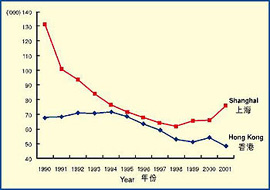
The Asian stereotype
The image of 40 or more children sitting in neat rows
of desks following the teacher in a series of carefully orchestrated drills
is typical among Western perceptions of the Asian classroom. This stereotype
has recently been challenged by a number of innovations in the Asian region
which have taken advantage of population change to implement new approaches
to teaching and learning based on smaller class sizes.
Class size has long been a concern of Asian educators. In Japan, Korea, Taiwan and Macau, reduction of class size has been placed high on the education policy agenda. Locally, smaller class sizes have been a recent subject of debate. In order to carry the debate forward, it is useful to investigate the experience of one important and well-known regional innovation. This article looks in detail at how Shanghai has managed to effect a significant reduction in the size of classes in its primary schools and considers what Hong Kong can learn from that experience.
Ip Kin-yuen
Department of Educational Policy and Administration
Lai Kwok-chan
Office of Planning and Academic Implementation

Figure 1 Number of births in Shanghai
and Hong Kong from 1990 to 2001